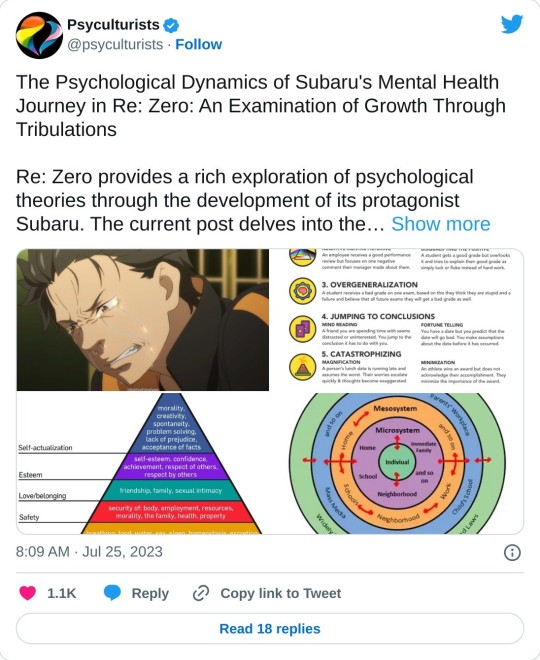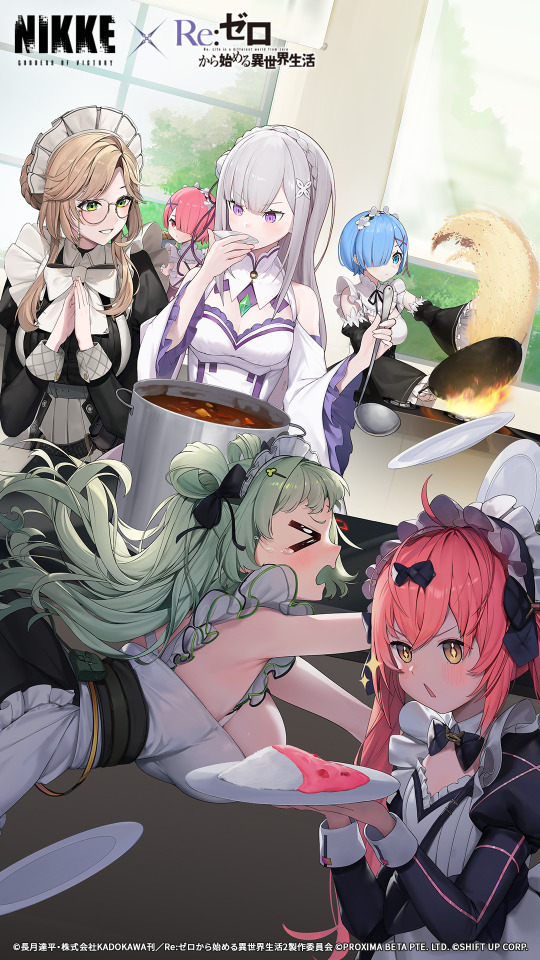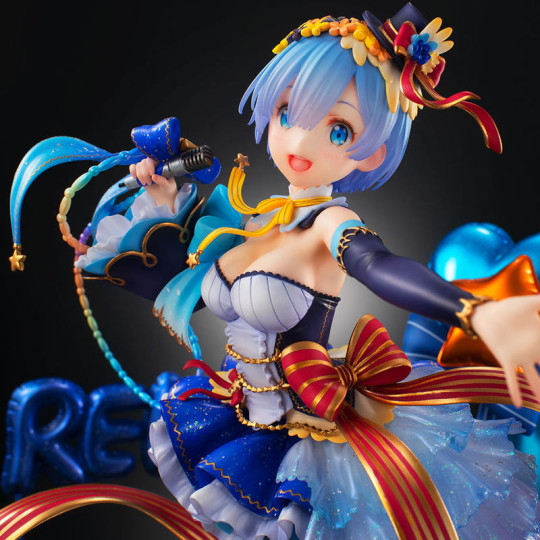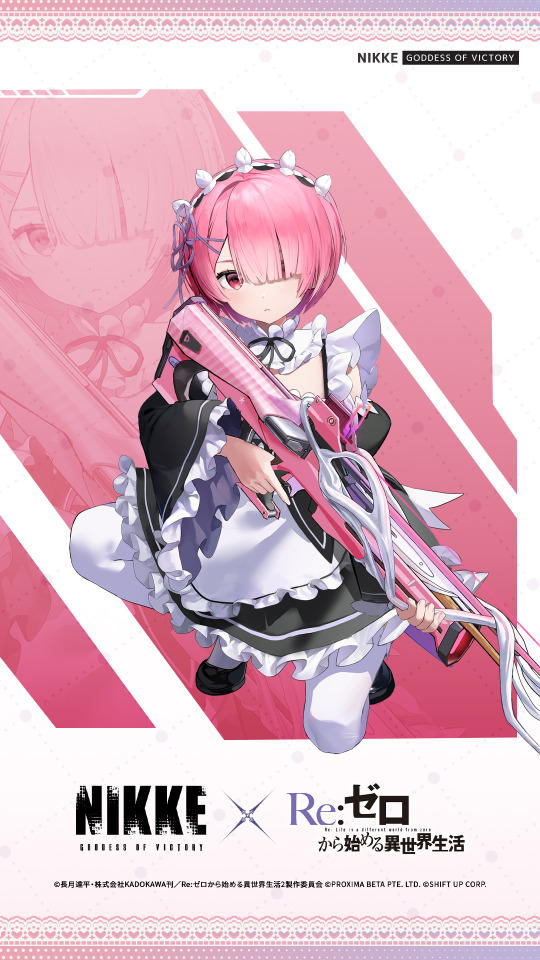#Re:Zero − Starting Life in Another World
Text
Ram from Re:Zero has to be one of my favorite portrayals of disability, I haven't gotten to Arc 6 but my friend showed me the part where it's displayed what Ram feels all the time and holy shit. Do I feel that.
Apparently a lot of people don't even realize Ram is a diaabled character, looking it up online leads to very very little about her as disabled rep. So I'll say it here. Ram is an amputee (her horn) who has Chronic Pain & Chronic Fatigue. She is disabled.
As someone who has such dehabiltating chronic pain, I have to use mobility aids almost every single day, Ram literally displays a condition like that in spades. This might be a bit of a nonsensical 3-AM type ramble but she's on my mind.
I tend to lose patience quicker than other people because of my body aching all the time and Ram, being the sassy, kinda bitchy asshole really fits this feeling as a disabled person. When you're in constant pain of course you're grouchy and it's a lot easier to let out that grouchiness in a playful way. I don't know if this was purposeful but either way it really really works. We need more mean disabled characters tbh.
Next is her being "useless." Subaru makes fun of her for not doing anything, and she takes the teasing in good fun. However, if/when Subaru takes it too far, the people who care about her are willing to stand up for her. Ram is disabled, she has little to no energy, she literally can't clean because it's exhausting and tiring and painful. I can relate to that as well, hell, I go to a special school because I am too tired and in too much pain to do normal amounts of schoolwork. So Ram being unable to do things like clean and cook, but still being valued speaks so much to disabled people who can't function alone!
Ram needing treatment every night... god. Having to take medication every single day as a disabled person is exhausting and forgetting to take it just once completely dehabilitates you. Ram needing treatment every night is literally the equivalent to magical daily medication.
Ram also using her wand as a mobility aid... that's not even a metaphor or allegory.
Yet despite all her shortcomings, her disability, she's loved and appreciated for the things she can do. She's respected and cared for and no one really looks down on her for being unable to do magic or simple tasks. (In the Movie, she even sleeps in and is affected by the cold more than anyone else. I don't know if this was on purpose, but that's also a thing people with chronic pain/fatigue deal with...) She's intelligent, loyal, clever, witty, bitchy but in a likeable way, and most of all. She's appreciated for her steamed potatoes.
Anyways this was my ted talk. Do you all realize Ram as the disabled rep she is...
321 notes
·
View notes
Photo

Ram Prize Figure by FuRyu, from Re:Zero − Starting Life in Another World
#ram#prize#figure#furyu#Re:Zero − Starting Life in Another World#re:zero#re zero#anime figure#anime figures#anime#figures#figurine#figurines#jirai kei#j fashion
129 notes
·
View notes
Text
Happy Birthday

Emilia (23rd September)
Re:Zero − Starting Life in Another World
#re:zero − starting life in another world#re:zero starting life in another world#re:zero kara hajimeru isekai seikatsu#re:zero emilia#rezero emilia#re zero emilia#emilia#fictional birthday#september#september 23rd
51 notes
·
View notes
Text

The Psychological Dynamics of Subaru's Mental Health Journey in Re: Zero: An Examination of Growth Through Tribulations
Re: Zero provides a rich exploration of psychological theories through the development of its protagonist Subaru. The current post delves into the psychological evolution of Subaru, focusing on Maslow's hierarchy of needs, Bowlby's attachment theory, Kohlberg's stages of moral development, defense mechanisms, Bronfenbrenner's ecological theory, cognitive distortions, and the concept of relapse in personal growth. This is all from Season 1 and Season 2, as I am an anime only. I will state that as the new season airs and more information comes to light, information is subject to change. This is not about diagnosing a character but rather understanding aspects of their mental health journey through a psychological perspective.
Maslow's Hierarchy of Needs and Subaru's Development Maslow's hierarchy of needs theory is a staple in the study of human motivation, proposing that humans are motivated to fulfill basic needs before moving on to more complex ones (Maslow, 1943). The hierarchy is usually depicted as a five-level pyramid, with physiological needs at the bottom, followed by safety, love and belonging, esteem, and self-actualization at the top. In Re: Zero, Subaru's journey through this hierarchy is not linear, with his position within the pyramid fluctuating based on circumstances and experiences. The physiological level, which includes food, water, warmth, and rest, is initially a priority for Subaru. Upon arriving in the alternate world, he grapples with these basic needs, with characters like Emilia and Rem assisting him. However, even after these needs are met, life-threatening events can throw him back to this level, showcasing a fluctuation within the pyramid. Safety needs become important as Subaru faces numerous perils in the new world. His need for personal security and safety is continuously threatened, particularly against violent deaths. Subaru often meets these needs using his unique ability to return by death, creating a safe outcome for himself and those around him. Love and belongingness needs are manifested in Subaru's interactions with Emilia, Rem, and Beako. The companionship and acceptance Subaru experiences through these relationships fulfill his need for love and belonging. However, situations such as Emilia's initial rejection of his overbearing protection can cause him to perceive a loss of this belonging, pushing him down the pyramid. Subaru's pursuit of esteem needs is evident in his constant drive for acknowledgment and respect, particularly from Emilia and Rem. However, frequent failures, rejections, and misunderstandings lead to fluctuations in this area. His dynamic relationship with Beako mainly tests his self-esteem. Self-actualization, the highest level, refers to the need to fulfill one's potential and is seen in Subaru's journey toward becoming a hero in the alternate world. This need is continuous and remains a constant objective for Subaru. However, as evident throughout the series, Subaru's progression to this stage is consistently challenged by the fluctuating state of his lower-level needs.

Bowlby's Attachment Theory, Defense Mechanisms, and Toxic Attachments Bowlby's attachment theory suggests that an individual's early relationships and attachments significantly influence their emotional development and interactions in later relationships (Bowlby, 1969). Subaru's relationships with Emilia, Rem, and Beako reflect various attachment styles, underpinning his emotional growth and development. With Emilia, Subaru tries to form a secure attachment, evident in his constant desire to be in her presence and the comfort he draws from their interactions. He trusts her and often seeks emotional refuge in her, indicative of the secure base in such attachments. However, Subaru's actual relationship with Emilia for most of the series so far presents a slightly different attachment style. While he exhibits affection for Emilia, his constant need to affirm his feelings suggests an anxious-preoccupied attachment. Here, Subaru's reliance on Emilia and others for emotional validation often leads to insecurity and anxiety. In a manner, Subaru seeks validation and approval from Emilia, like his yearning for his father's recognition. Subaru's relationship with Beako demonstrates a disorganized attachment style. This form of attachment is characterized by patterns of behavior that lack a coherent strategy for managing stress and fear (Bretherton, 1992). Subaru seems to fluctuate between seeking some form of comfort from Beako and being wary of her unpredictable responses, resulting in a complex and often turbulent dynamic.
Defense Mechanisms in Subaru's Psychological Development Let us talk a little about Subaru's coping strategies in the face of the series' numerous challenges, often aligning with classic defense mechanisms outlined in psychoanalytic theory. For example, he frequently uses denial, especially in the initial stages of the series. Unable to cope with the harsh reality of his situation, Subaru often ignores or denies some of the evident problems he encounters. As his journey progresses, he begins to employ more adaptive defense mechanisms. For instance, he uses humor to diffuse tense situations, a mechanism often associated with mature psychological coping. He also demonstrates sublimation, channeling his negative emotions into productive activities, like devising survival strategies or working towards resolving conflicts.
Toxic Attachments in Subaru's Relationships Although attachment forms the foundation of social bonds, it can also lead to toxic relationships when mismanaged. In Subaru's case, his strong attachments occasionally push him into toxic behavior. His attachment to Emilia, for instance, initially leads him to be overprotective and controlling, disregarding her autonomy. This behavior is typical of toxic attachment, where one person excessively depends on another for emotional support or validation. However, it is essential to note that Subaru learns from these negative experiences. He gradually understands the importance of respecting individual autonomy and independence, moving away from toxic behavior patterns as he grows. This transformation further underscores the importance of cognitive growth and self-awareness in establishing and maintaining healthy relationships.
Kohlberg's Theory of Moral Development and Subaru's Moral Maturation Subaru's moral growth can be explored using Kohlberg's theory of development (Kohlberg, 1981). This theory encompasses three stages; pre-conventional, conventional, and post-conventional, all of which can be observed in Subaru's relationships with Emilia, Rem, and Beako. Regarding Emilia, Subaru initially operates at the conventional stage by relying on deceit to navigate the unfamiliar world. However, as he matures, he begins to prioritize norms reflecting the conventional stage. As his connections with others deepen over time, Subaru's moral reasoning advances to the post-conventional stage. His selfless actions in protecting Emilia and Rem despite their objections demonstrate a standpoint and signify Subaru's’ progress from self-centeredness to becoming an empathetic and ethical individual (Gilligan, 1982).
Bronfenbrenner's Ecological Theory and Subaru's Growth Bronfenbrenner's Ecological Systems Theory suggests that an individual's development is influenced by systems of relationships that form their environment, ranging from immediate settings to broader social and cultural contexts (Bronfenbrenner, 1979). In Re: Zero, Subaru's growth, and development can be understood within the framework of these interacting systems. At the microsystem level, Subaru's immediate relationships with Emilia, Rem, and Beako shape his behaviors, emotions, and attitudes. Each relationship introduces unique challenges and rewards, significantly influencing his perception of himself and his environment. For instance, Subaru's growing emotional intelligence and resilience can be linked to his experiences within these microsystems. The mesosystem, which involves interactions between different elements of an individual's microsystem, also plays a crucial role in Subaru's growth. For example, the dynamics between Subaru, Emilia, and Rem introduce Subaru to the complexity of social interactions and the importance of understanding and managing interrelation conflicts. The exosystem, which includes environments not directly experienced but still influential, is represented by the broader political and social structures of the alternate world. Subaru's struggles and efforts to navigate these complex systems—such as the royal selection process and the conflicts between different factions—further drive his psychological and emotional growth. The outermost layer involving broader cultural values and customs, the macrosystem heavily influences Subaru's adaptation to the new world. The values and social norms of the alternate world, distinct from his own, compel Subaru to reassess his behaviors, attitudes, and beliefs, fostering personal growth. Lastly, the chronosystem, encompassing changes over time, is fundamental to understanding Subaru's development. His unique ability to "return by death," which involves temporal changes, provides him with multiple opportunities to learn from his mistakes and adapt his behaviors accordingly.

Cognitive Distortions and Subaru's Psychological Evolution Subaru frequently experiences cognitive distortions, irrational thought patterns that tend to reinforce negative thoughts or emotions (Burns, 1989). The most prominent among them is catastrophic thinking, where Subaru perceives a situation as far worse than it is. This distortion is particularly apparent during his early days in the alternate world, where every challenge or setback is viewed as insurmountable, triggering extreme responses, such as desperate pleas for help or self-sacrificial actions. These cognitive distortions come to light in his relationship with his companions. For instance, when Emilia rejects Subaru's overbearing protection, he catastrophically perceives it as the end of their relationship. His interactions with Beako and Rem further amplify this cognitive distortion, where he sees every disagreement or conflict as a personal failure or an indication of their waning trust in him. However, through consistent exposure to his cognitive distortions and their subsequent consequences, Subaru gradually learns to address them. He learns that disagreements or conflicts are not always catastrophic and can be resolved through communication and mutual understanding. His repeated failures (relapses) and successes in navigating the new world's challenges reinforce this understanding.

Relapses and Personal Growth Subaru's' journey toward growth and understanding involves experiencing relapses as elements. According to the Transtheoretical Model of behavior change, setbacks or relapses are not indicators of failure but integral parts of the change process (Prochaska et al., 1992). This model recognizes that individuals attempting to change their behaviors do not follow a path. Rather a cyclical one encompassing stages like pre-contemplation, contemplation, preparation, action, maintenance, and even relapse. In Re: Zero, this cycle is evident through Subaru's’ ability to reset back to a point every time he dies. Each reset represents a relapse triggered by distortions or unsuccessful attempts at overcoming challenges. However, with each reset comes lessons for Subaru as he learns from his mistakes, reevaluates his approach, and develops strategies for survival and problem-solving. These repeated relapses and subsequent cycles of learning and growth significantly contribute to Subaru's development, emotional maturity, and moral evolution.
Conclusion The character growth and development of Subaru in Re: Zero explores many psychological theories within the complexities of his journey. From the perspective of Maslow's hierarchy of needs, Bowlby's attachment theory, and Kohlberg's moral development stages, this series gives us an insight into psychology. Subaru's use of defense mechanisms, interactions within Bronfenbrenner's ecological systems, ability to overcome distortions, and understanding that setbacks are part of personal growth all contribute to his development and maturity. Emilia, Rem, Beako, and all other characters play big roles in this journey as catalysts and companions for Subaru. They offer support while presenting challenges that help him grow, highlighting the significance of relationships in development.
35 notes
·
View notes
Text
5 Serial Anime Jepang Terpopuler Yang Mirip Seperti Steins;Gate
5 Serial Anime Jepang Terpopuler Yang Mirip Seperti Steins;Gate
Film & Anime Jepang – Anime Jepang telah dibagi menjadi lebih banyak genre baru-baru ini, beberapa serial anime yang sukses terdiri dari beberapa kategori termasuk klasik dan trendi, Steins;Gate merupakan salah satu mahakarya terbesar di tahun 2010-an, dikategorikan sebagai fiksi ilmiah, thriller, dan komedi.
Pinterest
Simak Juga : 5 Film Anime Jepang Mendatang Yang Akan Menjadi Film Anime…

View On WordPress
#Anime Jepang Terpopuler#Erased#film anime Jepang#Higurashi: When They Cry#Re:Zero − Starting Life in Another World#Steins;Gate#Summer Timer Rendering#Tokyo Revengers
0 notes
Text


#goddess of victory: nikke#nikke#勝利の女神:nikke#x#re:zero kara hajimeru isekai seikatsu#re:zero#re:zero starting life in another world#re:ゼロから始める異世界生活#soda#cocoa#ade#ram#emilia#rem#maid#official art#mypost#mypost:goddess of victory#mypost:rezero
191 notes
·
View notes
Text

#oficial art#re zero#re zero kara hajimeru isekai seikatsu#re:zero#re zero starting life in another world#re:ゼロから始める異世界生活#re:zero kara hajimeru isekai seikatsu#リゼロ#re:zero starting life in another world#re:zero memory snow#rezero memory snow#re zero memory snow#emilia re:zero#emilia re zero#emilia rezero#re zero emilia#re:zero emilia#rezero emilia#emilia tan#mangaka art#@minori_sisiza#エミリア生誕祭2023#エミリア
453 notes
·
View notes
Text


Rem ; Re:Zero - Starting Life in Another World ☆ Alpha Satellite
#rem#rem figure#re:zero rem#re zero rem#rezero rem#re:zero#re zero#rezero#re zero figure#re: life in a different world from zero#re:zero starting life in another world#re:zero kara hajimeru isekai seikatsu#alpha satellite#anime#anime figure#anime figurine#figure#figure collecting#scale figure#figurine#anime collecting#myfigurecollection#manga
64 notes
·
View notes
Text

Emilia Figure by Good Smile Company, from Re:Zero − Starting Life in Another World
#emilia#figure#prepainted#misc#pop up parade#good smile company#re:zero#rezero#Re:Zero Starting Life in Another World#Re:Zero − Starting Life in Another World#Re:Zero kara Hajimeru Isekai Seikatsu#anime figure#anime figures#anime#figures#figurine#figurines
82 notes
·
View notes
Text
Happy Birthday

Natsuki Subaru (1st April)
Re:Zero
#re:zero#rezero#re zero#re:zero − starting life in another world#re:zero starting life in another world#re:zero kara hajimeru isekai seikatsu#re:zero natsuki#re:zero subaru#rezero natsuki#rezero subaru#natsuki re:zero#subaru re:zero#natsuki rezero#subaru rezero#subaru re zero#re zero subaru#natsuki subaru#subaru natsuki#fictional birthday#april#april 1st
12 notes
·
View notes
Link

#re zero#re:zero − starting life in another world#re:zero#re zero fanart#re:zero fanart#re zero starting life in another world#subaru x priscilla#priscilla x subaru#priscilla barielle#natsuki subaru#subaru natsuki
20 notes
·
View notes
Text






Rem : Aqua Dress [Re:Zero] 1/7 scale from Design Coco coming July 2024.
#Rem#Aqua Dress#Re:Zero#1/7 scale#Design Coco#Exclusive#Rem Rezero#Re Zero#Re:Zero kara Hajimeru Isekai Seikatsu#Re:Zero Starting Life in Another World#Re:Zero Rem#Rem Re:Zero
55 notes
·
View notes
Text


#goddess of victory: nikke#nikke#勝利の女神:nikke#x#re:zero kara hajimeru isekai seikatsu#re:zero#re:zero starting life in another world#re:ゼロから始める異世界生活#ram#guns#maid thigh highs#official art#mypost#mypost:goddess of victory#mypost:rezero
202 notes
·
View notes
Text

#oficial art#@sw_8a6u#art director#season 3#re zero#re:zero#re zero kara hajimeru isekai seikatsu#re zero starting life in another world#re:ゼロから始める異世界生活#rezero#re:zero kara hajimeru isekai seikatsu#re:zero starting life in another world#リゼロ#re:ゼロ#reゼロ#emilia re:zero#emilia rezero#subaru natsuki#natsuki subaru#subaru rezero#subaru re:zero#subaru re zero#beatrice rezero#beatrice re zero#beatrice re:zero#haruka sagawa#re:zero emilia#rezero emilia#beako rezero#エミリア
54 notes
·
View notes
Text

Feeling chilly out there this winter season? Take a cue from Rem and cuddle up in some warm winter wear. Extra points if it’s a cute outfit inspired by everyone’s favorite cute world-ending demon, Puck!
We are giving away this cute Coreful figure of Rem from Re:Zero dressed up in Puckwear! In addition to what's shown above, here are some other rules to note:
You must be following us to enter
You can double your entries by replying to our question "Who is your favorite anime 'mascot' character?"
We'll accept entries up to 11:59 p.m. ET on February 9th
International entries are welcome
No spam/contest-only accounts
BtT staff may not enter
Good luck! Oh, and remember, unlike with Subaru, you won’t have to die to try again and again—just like, reblog and reply! 😉
#Anime#Anime Giveaways#Giveaways#Re:ZERO#Rem#Puck#Re:ZERO: Starting Life in Another World#Re:Zero kara Hajimeru Isekai Seikatsu#Anime Article#Anime Blog#Articles#Christian Anime#Christian Otaku
53 notes
·
View notes